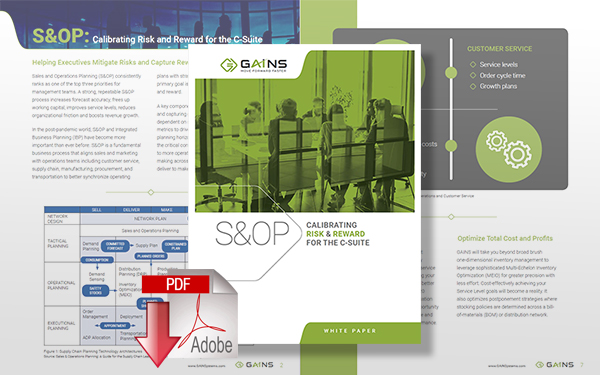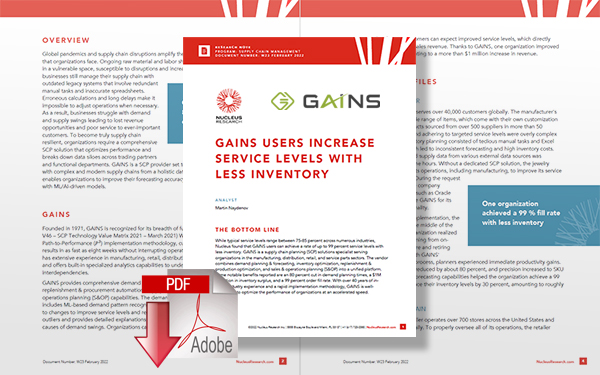Why Time to Value Matters in Supply Chain Transformation

If you are clamoring for supply chain transformation and cannot wait years to capture ROI, check out these highlights from a recent conversation with GAINS co-founder Bill Benton.
Q&A with GAINSystems Co-Founder Bill Benton
As companies seek to transform their supply chains, they are structuring their businesses for greater resilience, increased agility, and cost alignment in an ever-disrupted and dynamic global marketplace.
Market leaders are embracing innovative platforms that incorporate Artificial Intelligence (AI), machine learning, and advanced analytics to automate planning activities and accelerate decision-making.
Optimized supply chain planning can quickly lead to a competitive advantage – that is if you choose a platform that helps you accelerate time to value.
A 2022 McKinsey & Company operations practice report found that “Companies average 2.8 years from vendor selection to complete rollout. Industries with highly complex supply chains, such as pharmaceuticals, typically spend four to six years to fully implement a new supply chain planning system.”
If you are clamoring for supply chain transformation and cannot wait years to capture ROI, check out these highlights from a recent conversation with GAINS co-founder Bill Benton (pictured above) on how to accelerate time to value across 3, 6, and 12-month targets.
Let’s begin with the end in mind. Can you share a few examples of companies leveraging supply chain performance as the catalyst for business transformation?
Sure, our customer Stuller is one of the largest jewelry manufacturers in North America and prides itself on offering great service. Like most businesses, Stuller experienced significant disruptions during the pandemic. Its global supply chain network includes 40,000 customers in 140 countries and more than 500 suppliers in 50 countries spanning from India to South America, to the United States.
They needed to pivot very quickly and respond to increased customer demand along with increased sourcing complexity with numerous countries shutting down import/export operations. Stuller quickly deployed the GAINS Supply Chain Performance Optimization platform to increase automation, boost visibility and optimize planning.
They couldn’t wait years for ROI, they needed results fast. Working with GAINS, Stuller was up and running in just eight weeks and saw tangible results reducing demand planning effort by as much as 80% which freed up planners to engage in new value-added activities.
Does supply chain transformation always start with the same business process?
There’s no one size fits all formula. Every company and every supply chain is different and has different pressure points. At GAINS we work with the customer to focus on quick wins and then amplify the benefits over time. For example, Rockwell Automation recognized a significant opportunity to simultaneously reduce inventory surplus in some areas and invest in more inventory in areas where they needed more resilience.
So, Rockwell Automation’s supply chain transformation included augmenting their SAP footprint with GAINS for multi-echelon inventory optimization and then moved to supply planning, and then into sales and operations planning (S&OP).
Bill, when you and the GAINS team are accelerating time to value, are there multiple stage gates or intervals where benefits occur? How does that work?
We map out an onboarding process that incorporates a multi-phase, telescoping, horizon. Our goal is to achieve a tangible result within the first three months. So, we identify both internal and potentially ecosystem improvements such as process automation, reduction in lead time, reduced forecast variability by X percentage, or boosted service to a specific customer or channel. If you start with a fixed date and look to what’s feasible within that range, it increases focus and the team gets motivated by the quick and tangible win instead of waiting years to measure time to value.
In addition to prioritizing an initial win, we also identify parallel tracks that are all mutually reinforcing. Generally, we see a three-phased approach with 3, 6, and 12-month milestones along with a continuous improvement cycle of maturation. This value-driven philosophy is a key component of the GAINS Proven Path-to-Performance (P3) Methodology which is designed to drive quick results and continuous improvements while removing risk and accelerating time to value.
Can you describe the GAINS automated self-parameterization process?
The GAINS solution has built-in intelligence to recommend a default approach for everything, whether that’s stocking policy, level for stocking a bill of distribution or bill of materials (BOM), setting an SKU-specific service level, or the type of demand data to leverage for a new product.
These are just a few examples where the solution provides a baseline automatic recommendation. It’s very powerful and works as a glass box that allows the user to fine-tune the parameters as well. So, most deployments will start with automated self-parameterized configuration and then leverage tuning and training for greater precision over time.
Where are you seeing ripe opportunities for supply chain planning automation?
The speed and degree of automation will vary significantly by each organization. For example, Graybar, a very large North American distributor, automated 98% of all purchase orders and transfer line items in just 12 weeks.
Graybar took a highly selective approach to manual intervention. In other cases, it might take a client two years to get to that point. Automation is a great way to free up your supply chain planning talent to solve bigger problems or work more closely with customers and suppliers. And, with machine learning combined with the concept of explicable AI, users are trusting the automation faster than ever.
We are excited to bring automation to the table straight away but recognize it will get adopted differently or at a different rate by customers. For example, a client might be comfortable automating purchase lines that have less than a $5 value. Nobody’s going to lose their job over that. It’s a great way to prove automation works and then move up to purchase order line items of $500 or $5,000 or $50,000. We’ll help identify an incremental approach that is paced for the organization and help them harness the benefits of automation.
Getting back to time to value. You mentioned eight weeks to deploy at Stuller. And, just 12 weeks to achieve significant automation for Graybar. What is unique about GAINS and the way the solution is designed or your approach to onboarding customers?
Watch: Supply Chain Planning Transformation at Graybar by GAINSystems
We are able to implement faster and increase visibility in a fraction of the time and cost of most vendors in the market. We’ve talked about the GAINS Proven Path-to-Performance (P) Methodology which incorporates tangible, phased, and feasible milestones. This proprietary value prioritization framework drives quick results and continuous performance while removing risk and accelerating time to value.
The GAINS platform provides numerous advantages including a single canonical data model that accelerates the significant business modeling interdependence (also known as a digital twin) across everything from, network design and network flow all the way through sales and operations execution (S&OE).
This accelerates decision-making with confidence. For example, how do you allocate scarce componentry or scarce finish goods to specific orders right now? With visibility that spans strategic planning horizons and product flows across your network through to allocating products to specific orders. There is only one version of the truth.
Progressing from demand, forecasting, demand sensing, demand shaping, and collaborative demand planning into comprehensive inventory optimization, which we believe should encompass multi-echelon, whether that’s within a bill of material, within a bill of distribution, or both. And that’s quite crucial because of interdependence based on where stock is held and what the critical planning period for inventory deployment should be.
Or, understanding how inventory deployment drives supply planning as events change, whether it’s a late container, port congestion, lead times doubling due to scarcity, or customers shifting demand.
These are all real-life examples we’ve helped customers address. Responding to disruptions and opportunities is much easier with GAINS. Then bring it into a cohesive S&OP process where you can assess various business scenarios to act with greater confidence.
The advantage of a single data model with scenario planning, execution, working backward all the way through design where all the data is consistent, interactive, and interdependent is really an advantage with GAINS.
Let’s talk about time to value and ROI derived from supply chain transformation initiatives. What horizon should we consider?
Generally, you should target at least a 5X return on your total supply chain transformation investment. As you start a project, determine how you calibrate that impact with goals that can be measured and monetized.
For example, if we increase our perfect order fill rate - meaning shipping the amount requested, on time, from the ideal source. What does that mean? How can we describe that to our CFO in a way that she would understand?
Every company is grappling with longer lead times and exponentially higher distribution costs given the constraints in areas like container shortages, port capacity, or tucking availability combined with product shortages. Any final advice to consider on the topic of time to value?
Don’t let perfection impede your progress. Determine what you can do now that is meaningful. Find quick wins that you can use as tangible examples to build momentum. If solution providers are coming up with proposals that say it’s going to take years to get to a meaningful and tangible set of benefits, maybe that’s valid. But in parallel, you should be generating some quick wins along the way. Make sure that the solution you’ve selected is designed for quick deployment and the solution provider has a track record of delivering rapid time to value.
Related Resources
S&OP: Calibrating Risk & Reward for the C-Suite
This whitepaper shares the key metrics that bring supply chain, sales, finance, customer service, and operations executives together in their assessment of risk and reward. Download Now!
Gains Users Increase Service Levels With Less Inventory
Nucleus interviewed several GAINS customers to identify the key benefits and how users benefitted from increased productivity, reduced operational costs, better service levels, and new business insights. Download Now!
More from GAINSystems
Related Article: Why Time to Value Matters in Supply Chain Transformation
Article Topics
GAINSystems News & Resources
Talking Supply Chain: Embracing VUCA How Executives Can Mitigate Risks and Capture Rewards with S&OP, Sales and Operations Planning S&OP: Calibrating Risk & Reward for the C-Suite Why Time to Value Matters in Supply Chain Transformation Gains Users Increase Service Levels With Less InventoryLatest in Supply Chain
Is There a Next Generation of Truckers? Data Reveals Grim Outlook A Look at Baltimore’s Key Bridge Collapse—One Month Later European Parliament Passes New Law Requiring Supply Chain Accountability Baltimore Continues Bridge Recovery With Opening of New Channel How Shippers Can Prep for Hurricane Season Apple Accused of Multiple Human Rights Violations South Korea Finally Overtakes China in Goods Exported to U.S. More Supply Chain
















